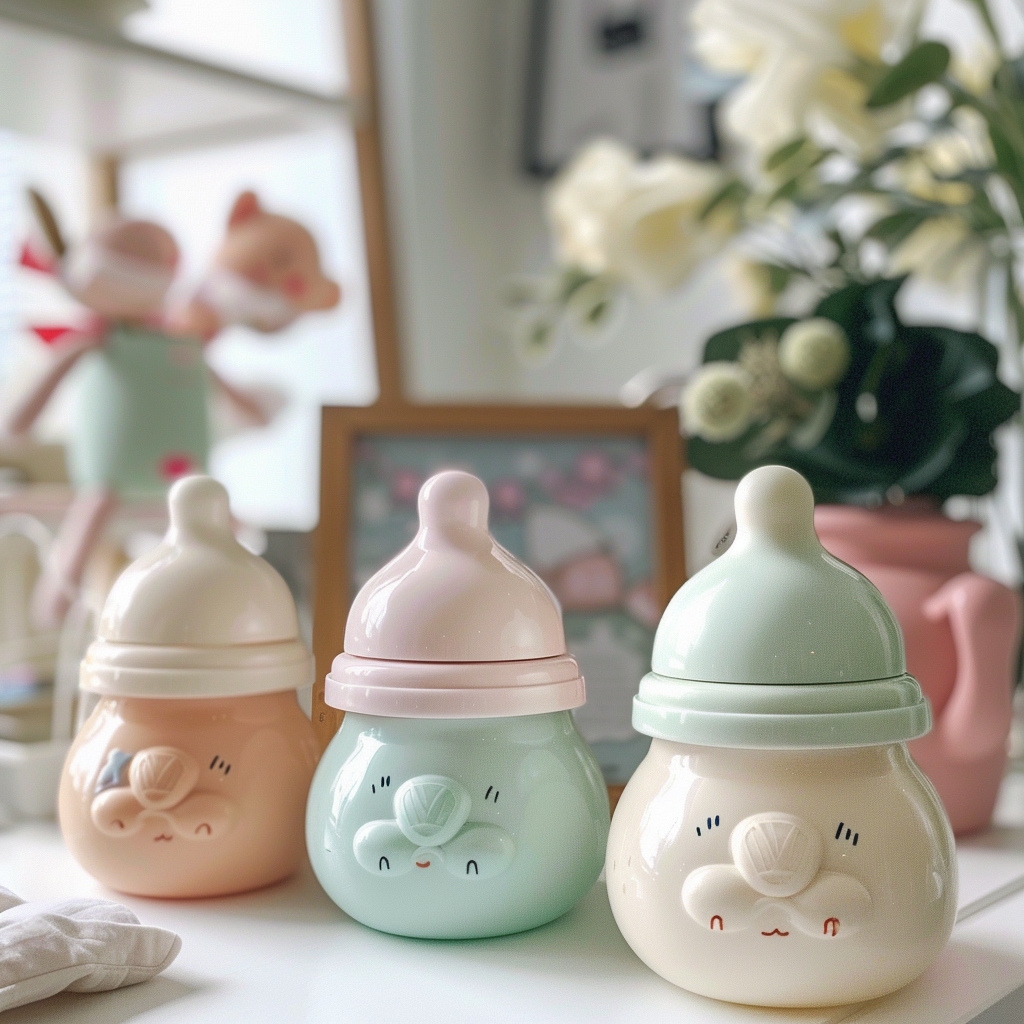
Welcome, new moms and dads! We all know that breastfeeding is often considered the gold standard for feeding newborns, providing a host of benefits for both baby and mother. However, we understand that breastfeeding isn’t always an option for everyone, and that’s perfectly okay. Whether it’s due to medical reasons, lifestyle choices, or personal preferences, formula feeding is a viable and healthy alternative.
In this article, you’ll find a comprehensive guide to formula feeding, filled with practical tips and detailed information to help you make the best choices for your little one. From choosing the right formula to proper feeding techniques and storage tips, we’ve got you covered. Let’s embark on this journey together and ensure your baby gets the best nutrition possible, no matter the method.
When it comes to formula feeding, choosing the right formula for your baby is crucial as it serves as either a supplement or a complete source of nutrition. Here’s what you need to consider regarding formula, including usage instructions, stock recommendations, and brand suggestions.
Choosing the Right Formula
Types of Baby Formula
- Cow’s Milk-Based Formula:
- Overview: The most commonly used type of formula, made from cow’s milk that has been altered to resemble breast milk. It contains the right balance of proteins, fats, and carbohydrates.
- Best For: Most healthy full-term babies.
- Example Brands: Similac Advance, Enfamil NeuroPro.
- Soy-Based Formula:
- Overview: Made from soy proteins, it’s an alternative for babies who are lactose intolerant or allergic to cow’s milk protein.
- Best For: Babies with lactose intolerance or milk allergies, or families who prefer a vegetarian diet.
- Example Brands: Enfamil ProSobee, Similac Soy Isomil.
- Hydrolyzed Formula:
- Overview: The proteins are broken down into smaller pieces, making it easier to digest and less likely to cause an allergic reaction.
- Best For: Babies with protein allergies, digestive issues, or at high risk of allergies.
- Example Brands: Gerber Extensive HA, Similac Alimentum.
- Specialized Formula:
- Overview: Designed for babies with specific health needs, such as premature babies or those with medical conditions.
- Best For: Babies with particular medical conditions or dietary needs, often recommended by a pediatrician.
- Example Brands: Enfamil EnfaCare (for premature babies), Neocate (for severe allergies).

Usage Instructions
- Wash Hands and Bottles: Hygiene is crucial. Always start by washing your hands thoroughly. Sterilize bottles, nipples, and other feeding equipment before each use.
- Follow the Mixing Instructions: Each formula brand may have slightly different mixing instructions. Typically, it’s one scoop of formula to two ounces of water, but always check the can for specific instructions.
- Use the Right Water: Use boiled and cooled water or distilled water to ensure it’s safe for your baby.
- Mix Thoroughly: Ensure the powder is fully dissolved by shaking or stirring well. Undissolved powder can cause digestive discomfort.
- Check the Temperature: Before feeding, test the formula on your wrist to ensure it’s not too hot. It should be lukewarm, close to body temperature.
Key Considerations
- Consult Your Pediatrician: Your pediatrician can provide personalized advice based on your baby’s health, growth, and any potential allergies.
- Watch for Allergies: Symptoms like excessive crying, vomiting, diarrhea, or rashes could indicate an allergy. If you notice these signs, contact your pediatrician immediately.
Formula Feeding Guide: First 3 Months
Creating a weekly stock chart for baby formula over the first three months can help you manage supplies efficiently and ensure you always have enough on hand. The amount of formula needed can vary significantly depending on the baby’s age, growth, and appetite. Below, I’ll outline a general guide based on average consumption.
Month 1 (Weeks 1-4)
- Age: Newborn to 1 month
- Average Daily Intake: 2-3 ounces (60-90 ml) per feeding
- Feeding Frequency: Every 2-3 hours (8-12 times per day)
- Weekly Consumption: Approximately 140-252 ounces (4,140-7,440 ml)
- Containers Needed Per Week: Assuming a container holds 900 grams (equivalent to around 2,000 ml prepared formula), about 2-4 containers.
Month 2 (Weeks 5-8)
- Age: 1 month to 2 months
- Average Daily Intake: 4-5 ounces (120-150 ml) per feeding
- Feeding Frequency: Every 3-4 hours (6-7 times per day)
- Weekly Consumption: Approximately 168-245 ounces (4,980-7,245 ml)
- Containers Needed Per Week: Assuming a container holds 900 grams (equivalent to around 2,000 ml prepared formula), about 2-4 containers.
Month 3 (Weeks 9-12)
- Age: 2 months to 3 months
- Average Daily Intake: 4-6 ounces (120-180 ml) per feeding
- Feeding Frequency: Every 4 hours (5-6 times per day)
- Weekly Consumption: Approximately 140-252 ounces (4,140-7,440 ml)
- Containers Needed Per Week: Assuming a container holds 900 grams (equivalent to around 2,000 ml prepared formula), about 2-4 containers.

Example Stock Chart
Week | Daily Feeding (oz) | Feedings per Day | Total Weekly Consumption (oz) | Containers Needed (assuming 2,000 ml/container) |
1 | 2-3 | 12 | 168-252 | 2-4 |
2 | 2-3 | 12 | 168-252 | 2-4 |
3 | 2-3 | 12 | 168-252 | 2-4 |
4 | 2-3 | 12 | 168-252 | 2-4 |
5 | 4-5 | 8 | 224-280 | 3-4 |
6 | 4-5 | 8 | 224-280 | 3-4 |
7 | 4-5 | 7 | 196-245 | 2-4 |
8 | 4-5 | 7 | 196-245 | 2-4 |
9 | 4-6 | 6 | 168-252 | 2-4 |
10 | 4-6 | 6 | 168-252 | 2-4 |
11 | 4-6 | 6 | 168-252 | 2-4 |
12 | 4-6 | 6 | 168-252 | 2-4 |
Daily Example Stock Chart for the First Month
For a newborn (first month):
Time | Amount (ounces) | Notes |
6:00 AM | 3 | Freshly mixed, morning feeding |
9:00 AM | 3 | Keep baby upright after feeding |
12:00 PM | 3 | Check for hunger cues |
3:00 PM | 3 | Always burp baby after feeding |
6:00 PM | 3 | Freshly mixed, evening feeding |
9:00 PM | 3 | Nighttime feed |
12:00 AM | 3 | Late-night feed |
3:00 AM | 3 | Early morning feed |
Total: 24 ounces
Daily Example Stock Chart for the Second Month (1-2 months)
At this stage, babies typically consume 3-4 ounces per feeding, every 3-4 hours.
| Time | Amount (ounces) | Notes |
| 6:00 AM | 4 | Freshly mixed, morning feeding |
| 9:00 AM | 4 | Keep baby upright after feeding |
| 12:00 PM | 4 | Check for hunger cues |
| 3:00 PM | 4 | Always burp baby after feeding |
| 6:00 PM | 4 | Freshly mixed, evening feeding |
| 9:00 PM | 4 | Nighttime feed |
| 12:00 AM | 4 | Late-night feed |
| 3:00 AM | 4 | Early morning feed |
Total: 32 ounces
Daily Example Stock Chart for the Third Month (2-3 months)
During the third month, babies generally consume 4-5 ounces per feeding, every 3-4 hours.
| Time | Amount (ounces) | Notes |
| 6:00 AM | 5 | Freshly mixed, morning feeding |
| 9:00 AM | 5 | Keep baby upright after feeding |
| 12:00 PM | 5 | Check for hunger cues |
| 3:00 PM | 5 | Always burp baby after feeding |
| 6:00 PM | 5 | Freshly mixed, evening feeding |
| 9:00 PM | 5 | Nighttime feed |
| 12:00 AM | 5 | Late-night feed |
| 3:00 AM | 5 | Early morning feed |
Total: 40 ounces

Tips for Adjusting Feeds
- Watch for Hunger Cues: Signs include sucking on hands, making sucking noises, or rooting (moving head around in search of the nipple).
- Growth Spurts: During growth spurts, your baby might temporarily want to eat more often.
- Stay Flexible: Some days your baby might want more or less formula. It’s normal for their appetite to vary slightly.
- Purchasing: Consider buying in bulk for convenience and potential cost savings, but be mindful of the formula’s expiration dates.
This chart is an estimate and serves as a starting guide. Monitor your baby’s hunger cues and weight gain and adjust as recommended by your pediatrician. Also, keep in mind that babies might have growth spurts where their intake may increase temporarily. By staying attentive to your baby’s needs and maintaining a flexible feeding routine, you’ll ensure they get the nutrition they need to grow healthy and strong.
Additional Tips for Successful Formula Feeding
1. Understanding Baby’s Cues
- Hunger Cues: Besides rooting and sucking on hands, other signs include smacking lips, fussiness, and opening and closing their mouth. Crying is often a late sign of hunger.
- Fullness Cues: Signs include slowing down sucking, turning away from the bottle, or pushing the bottle away. Respect these cues to avoid overfeeding.
2. Feeding Environment
- Calm and Quiet: Create a calm, quiet environment for feeding to help your baby focus and enjoy their feeding time.
- Comfortable Position: Hold your baby in a semi-upright position to prevent milk from flowing too quickly and causing discomfort or spitting up.
3. Burping Your Baby
- Burp During and After Feedings: Burp your baby midway through and after feedings to release any air they may have swallowed. This can help reduce gas and discomfort.
- Techniques: Gently pat your baby’s back while they are positioned over your shoulder, sitting on your lap, or lying face-down across your lap.
4. Proper Bottle Care
- Sterilization: For the first few months, it’s important to sterilize bottles and nipples before each use. You can use a sterilizer, boil them in water, or use sterilizing tablets.
- Cleaning: After each feeding, wash bottles and nipples thoroughly with hot, soapy water and a bottle brush, or run them through the dishwasher if they are dishwasher-safe.
5. Storing Formula
- Prepared Formula: Prepared formula can be stored in the refrigerator for up to 24 hours. Discard any unused formula that has been left at room temperature for more than an hour.
- Powdered Formula: Keep the formula container tightly closed and store it in a cool, dry place. Use within the timeframe specified on the packaging after opening.
6. Travel and Outings
- Pre-Measured Formula: For convenience, pre-measure formula into a clean, dry container and bring along bottled water to mix when needed.
- Ready-to-Feed Bottles: Consider using ready-to-feed formula bottles for outings. They are pre-mixed and don’t require refrigeration until opened.
7. Tracking Feedings
- Feeding Log: Keep a feeding log to track how much and how often your baby is eating. This can be helpful information for your pediatrician and can alert you to any changes in feeding patterns.
- Growth Spurts: Be aware of periods when your baby may have increased appetite due to growth spurts, which typically occur around 2-3 weeks, 6 weeks, and 3 months of age.
Addressing Common Concerns
- Spit-Up: It’s normal for babies to spit up a little after feedings. Ensure your baby is burped frequently and avoid overfeeding. If spitting up is excessive or your baby seems uncomfortable, consult your pediatrician.
- Constipation: Formula-fed babies might experience firmer stools. Ensure your baby is adequately hydrated, and speak with your pediatrician if constipation becomes an issue.
- Gas: Some babies may swallow air during feedings, leading to gas. Burp your baby well and consider using anti-colic bottles designed to reduce air intake.
Enjoy the Journey!
Remember, feeding time is not just about nutrition but also a special time for bonding. Talk to your baby, make eye contact, and enjoy these moments of closeness. Each baby is unique, and you’ll quickly learn what works best for you and your little one. Trust your instincts, and don’t hesitate to reach out for support or advice when needed.
Congratulations again on your new arrival! You’re doing an incredible job, and with these tips, formula feeding can become a smooth and enjoyable part of your parenting journey. Happy feeding!


